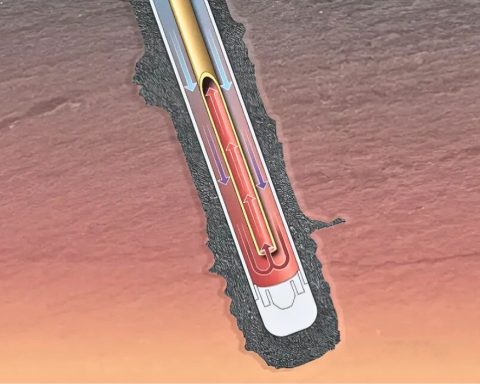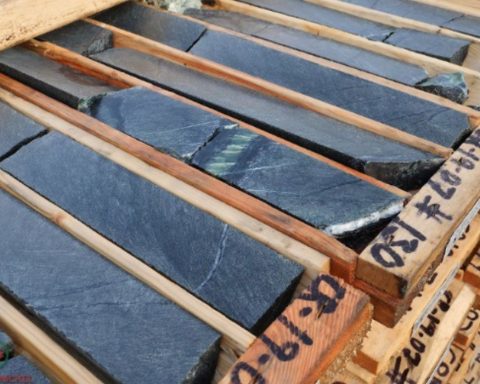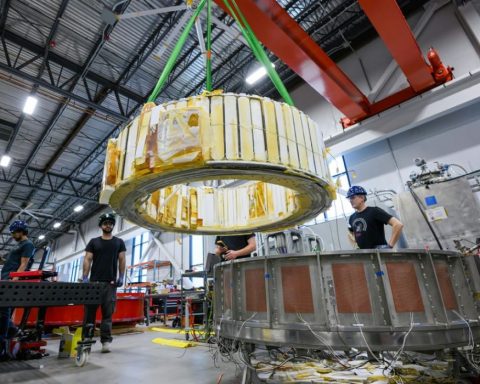After the world has collectively dragged its feet for far too long to slow down climate change, companies and governments are now championing a deceptively simple solution: filtering carbon dioxide out of the air and burying it deep underground, or turning it into everything from jet fuel to yoga mats.
The technology, known as direct air capture, has lately gathered steam as climate scientists warn that, without it, humanity stands little chance of limiting global warming to acceptable levels. In its latest report, the Intergovernmental Panel on Climate Change said that using carbon removal – which also includes measures such as planting trees or enriching the soil with minerals – will be “unavoidable” if the world wants to hit net-zero emissions.
Buoyed by those predictions, the industry has already gathered serious momentum. U.S. President Joe Biden’s infrastructure package allocated $3.5 billion for several direct-air-capture hubs last year, and plans are underway to build the first truly large-scale plant in the southwestern United States, which will eventually trap up to one million tonnes a year.
Private investors have also piled in: Climeworks, a Swiss company that is one of the burgeoning industry’s biggest players, bagged US$650 million in its latest round of fundraising. And corporations from tech giant Alphabet to payments company Stripe recently committed close to US$1 billion to buy removals from innovative start-ups in the space.
That is not to say direct air capture is without its critics. Some point out that the vast amounts of energy needed to draw heavily diluted carbon out of the air is better used elsewhere. Others fear that relying on so-called negative emissions technologies is merely giving high-emitting companies an excuse to keep on polluting, with catastrophic consequences for the climate.
Although it may sound high-tech, drawing carbon from the air is surprisingly straightforward in practice. At Climeworks’s flagship facility in Iceland, the largest in the world, stacks of giant fans suck in the ambient air; inside, it passes over a filter that collects the carbon dioxide, which is then released under high heat. (Other companies separate the carbon by passing air through chemical solutions instead.) Nearby, another plant run by the Icelandic company Carbfix mixes the concentrated carbon with water inside a group of pentagonal spheres that lend the site the eerie look of a space colony. The mixture is then pumped deep underground, where it reacts with basalt rock and turns solid within a few years.
That the plant sits in Iceland is no accident: the country has plenty of clean geothermal energy for the power-hungry process, as well as suitable geological storage to permanently sequester the carbon. Under those conditions, direct air capture can have a much higher impact than capturing emissions from factories or power plants, since it traps CO2 without releasing any emissions in the first place.
That promise and the potential to use the captured carbon for a range of low-carbon technologies – mixing it into cement or producing jet fuel and feedstocks for plastics, for example – has attracted big names from sectors that are notoriously hard to decarbonize. United Airlines has directly invested millions in the first large-scale project being built in the United States, which is being developed by Houston-headquartered oil firm Occidental and will partly use the captured carbon to make jet fuel. Other major companies from Shell to Apple also rely on carbon removal in their net-zero plans. And 18 of the 50 countries that have submitted long-term climate strategies to the UN specifically mention technological carbon removal.
One caveat to direct air capture’s climate potential is the type of energy used. Researchers have found that rapid, large-scale deployment of the technology could require up to a quarter of global energy demand by 2100, underscoring the need to use renewable energy or waste heat.
It’s absolutely not a magic bullet; it’s absolutely not an alternative to mitigation. But we do need this … to undo the damage that we’ve done.
—Niall Mac Dowell, Imperial College London
For now, the technology is also still expensive: Occidental estimates that it will cost between US$300 and $425 to sequester each tonne of carbon at its plant. Companies throughout the industry are confident that successive projects will drive costs down quickly. Nevertheless, even some of the industry’s champions are skeptical of the slew of start-ups that have sprung up.
“You are seeing lots of people making big promises right now, and they don’t quite know how to keep them,” Klaus Lackner, the director of Arizona State University’s Center for Negative Carbon Emissions and a pioneer in direct air capture technology, told the MIT Technology Review.
Perhaps the most common criticism of carbon removal, and one that has dogged direct air capture for years, is that it could afford companies a fig leaf to keep pumping out CO2 by relying on technology that is not guaranteed to become commercially successful.
Executives at direct-air-capture companies are quick to echo what experts have long emphasized, however: that cutting emissions first should be every company’s priority. “The best way is not to clean up your mess; the best way is to not cause the mess in the first place,” says Andreas Aepli, Climeworks’s CFO.
Aepli thinks the relatively high cost of direct air capture means most companies still have every incentive to prioritize emission cuts. But he also points to growing scientific consensus around carbon removal, with most assessments estimating that we will ultimately need to remove between five and 15 billion tonnes of carbon a year by 2050 to keep global warming to 1.5°C. Under the International Energy Agency’s net-zero scenario, direct air capture alone is projected to sequester close to one billion tonnes a year.
Nature-based carbon removal, such as planting trees, is certain to play a larger role, too. But there are limits to growing forests, and wildfires can quickly release all that trapped carbon. That means technological carbon removal will likely be necessary to compensate for emissions from hard-to-abate sectors like aviation or heavy industry, as well as to draw down already accumulated emissions in the atmosphere.
“It’s absolutely not a magic bullet; it’s absolutely not an alternative to mitigation,” says Niall Mac Dowell, a professor at Imperial College London who studies carbon removal. “But we do need to do this … to undo the damage that we’ve done.”
That also leaves the companies that are championing carbon removal with a daunting task. For now, Climeworks’s flagship plant in Iceland traps only about 4,000 tonnes of carbon per year; altogether, the roughly 20 direct-air-capture pilot plants operating around the world have capacity for around 10,000 tonnes – far from making a meaningful impact.
You are seeing lots of people making big promises right now, and they don’t quite know how to keep them.
—Klaus Lackner, director of Arizona State University’s Center for Negative Carbon Emissions
Another question is what to do with the captured carbon. Early projects have focused on selling it for use in a wide range of consumer goods, from fizzy drinks and vodka to diamonds and watches, and start-ups focusing on niche applications now abound. But experts and executives at direct-air-capture companies agree that the most effective pathway will be storing it away permanently.
“We can make yoga pants out of carbon,” says Lori Guetre, head of business development at British Columbia–based Carbon Engineering, which is providing the technology for Occidental’s plant. “But each one of those markets is small. And what we find, even when we talk to cement production plants, is they only need a really small amount of CO2 per plant.”
That’s not to say the explosion in so-called carbon tech is not useful to help kickstart the industry. Lauren Riley, head of sustainability at United Airlines, says sustainable jet fuel will play a large role in the company’s reaching its net-zero goal. But since it could be decades until that is available at the necessary volume and price, financing carbon removal in the meantime makes sense. “It’s a very practical solution to enable that transition,” she says.
“Obviously, if you’re talking about battling climate change, you’re going to ultimately need some level of sequestration,” says Fred Moesler, chief technology officer at Global Thermostat, another direct-air-capture company that is building its own plant in Colorado. “But I really think we should be doing everything at this point in time to encourage technologies like ours to develop.”
Despite the explosion in corporate interest, companies in the industry say direct air capture will take off only if governments incentivize it by creating mandatory markets. Occidental’s plant in the Permian Basin, which combines carbon sequestration with jet fuel production and enhanced oil recovery, is taking advantage of tax credits and low-carbon fuel standards. Incentives have also ramped up in Canada, where the most recent budget proposed a 60% tax credit for direct-air-capture projects. Most promisingly, recent bills introduced by Democratic lawmakers at the U.S. federal level and in New York State would see the government directly procure carbon removal.
“We’re super excited about the voluntary market, but we see it as a means to accelerate how quickly we can get going,” says Guetre. “It’s not going to do the heavy lifting over time for these projects.”
Jennifer Wilcox, principal deputy assistant secretary for the Office of Fossil Energy and Carbon Management at the U.S. Department of Energy, acknowledges that available tax credits are still “a drop in the bucket” for direct-air-capture projects. But she says it’s still premature to discuss public procurement of carbon removals, since metrics for measuring the sustainability of emissions savings still need to be ironed out.
“I think we still have a lot of work cut out for us with the investments that we’ve already been making,” Wilcox says.
In the meantime, Occidental is already planning dozens of plants alone and Carbon Engineering has struck similar partnerships with developers in Canada, the United Kingdom and Norway. Climeworks is planning to use its own design in a series of larger installations over the coming years, ultimately reaching its own megatonne plant. That’s not to mention all the smaller companies waiting in the wings.
With many experts now saying that direct air capture will be necessary to rein in climate change, the biggest challenge for the technology, arguably, is growing quickly enough before it is too late.
“There’s really no way to get to net-zero without carbon removal, both natural and technological,” says Katie Lebling, a carbon removal expert at the World Resources Institute. “And the need for it will only increase.”
Yannic Rack is a journalist based in London and mainly writes about business, climate change and the environment.






